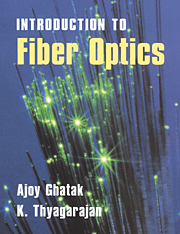Book contents
- Frontmatter
- Contents
- Preface
- Acknowledgments
- Abbreviations
- 1 Introduction: The fiber optics revolution
- 2 Basic optics
- 3 Basic characteristics of the optical fiber
- 4 Ray paths and pulse dispersion in planar optical waveguides
- 5 Pulse dispersion in graded index optical fibers
- 6 Material dispersion
- 7 Modes in planar waveguides
- 8 Propagation characteristics of a step index fiber
- 9 Propagation characteristics of graded index fibers
- 10 Waveguide dispersion and design considerations
- 11 Sources for optical fiber communication
- 12 Detectors for optical fiber communication
- 13 Design considerations of a fiber optic communication system
- 14 Optical fiber amplifiers
- 15 Dispersion compensation and chirping phenomenon
- 16 Optical solitons
- 17 Single-mode fiber optic components
- 18 Single-mode optical fiber sensors
- 19 Measurement methods in optical fibers: I
- 20 Measurement methods in optical fibers: II
- 21 Periodic interactions in waveguides
- 22 The ray equation in cartesian coordinates and its solutions
- 23 Ray paths and their classification in optical fibers
- 24 Leaky modes
- Appendix A Solution of the scalar wave equation for an infinite square law medium
- Appendix B The far-field pattern
- Appendix C WKB analysis of multimode fibers
- Appendix D Gaussian envelope approximation
- Appendix E Coupled-mode equations
- Appendix F Derivation of coupled-mode equation for periodic coupling
- Appendix G Leakage loss in optical waveguides
- References
- Index
19 - Measurement methods in optical fibers: I
Published online by Cambridge University Press: 05 June 2012
- Frontmatter
- Contents
- Preface
- Acknowledgments
- Abbreviations
- 1 Introduction: The fiber optics revolution
- 2 Basic optics
- 3 Basic characteristics of the optical fiber
- 4 Ray paths and pulse dispersion in planar optical waveguides
- 5 Pulse dispersion in graded index optical fibers
- 6 Material dispersion
- 7 Modes in planar waveguides
- 8 Propagation characteristics of a step index fiber
- 9 Propagation characteristics of graded index fibers
- 10 Waveguide dispersion and design considerations
- 11 Sources for optical fiber communication
- 12 Detectors for optical fiber communication
- 13 Design considerations of a fiber optic communication system
- 14 Optical fiber amplifiers
- 15 Dispersion compensation and chirping phenomenon
- 16 Optical solitons
- 17 Single-mode fiber optic components
- 18 Single-mode optical fiber sensors
- 19 Measurement methods in optical fibers: I
- 20 Measurement methods in optical fibers: II
- 21 Periodic interactions in waveguides
- 22 The ray equation in cartesian coordinates and its solutions
- 23 Ray paths and their classification in optical fibers
- 24 Leaky modes
- Appendix A Solution of the scalar wave equation for an infinite square law medium
- Appendix B The far-field pattern
- Appendix C WKB analysis of multimode fibers
- Appendix D Gaussian envelope approximation
- Appendix E Coupled-mode equations
- Appendix F Derivation of coupled-mode equation for periodic coupling
- Appendix G Leakage loss in optical waveguides
- References
- Index
Summary
Introduction
Characterization of optical fibers is very important for a number of reasons. The users of optical fibers need the fiber characteristics to design the optical fiber communication system, whereas the manufacturers need them for optimizing their fabrication processes to obtain fibers with desired characteristics. The fiber characteristics are also necessary for the development and verification of various theoretical models for predicting various performance properties of the fiber. The two most important characteristics of an optical fiber are bandwidth (or pulse dispersion) and loss. In addition, one requires knowledge of various other parameters such as refractive index profile, core diameter, and so forth for predicting losses at joints. Table 19.1 lists the various characteristics of optical fibers along with their effect on system performance.
A large number of techniques have been developed for measuring various fiber characteristics. In this and the following chapter, we briefly discuss some of the standard techniques used in fiber characterization; for more details of the various techniques, readers may consult Pal, Thyagarajan, and Kumar (1988) and Thyagarajan, Pal, and Kumar (1988b).
In Section 19.2 we discuss some general experimental considerations relevant to fiber measurements, and in Section 19.3 we discuss various techniques for the measurement of refractive index profile, spectral attenuation and pulse dispersion, or bandwidth. In Chapter 20 we discuss measurement of characteristics specific to single-mode fibers only – namely, mode field diameter, cutoff wavelength, and birefringence.
- Type
- Chapter
- Information
- An Introduction to Fiber Optics , pp. 411 - 429Publisher: Cambridge University PressPrint publication year: 1998



